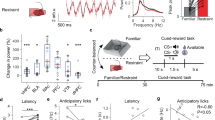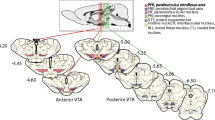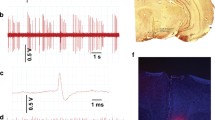Abstract
Rationale
The ventral tegmental area (VTA) is implicated in the pathophysiology of depression and addictive disorders and is subject to the detrimental effects of stress. Chronic stress may differentially alter the activity pattern of its different subregions along the rostrocaudal and dorsoventral axes, which may relate to the variable behavioral sensitivity to stress mediated by these subregions.
Objectives
Here, chronic stress-exposed rats were tested for depressive-like reactivity. In situ hybridization for zif268 as a marker of neuronal activation was combined with in vivo single-unit recording of dopaminergic neurons to assess modifications in the activity of the rostral VTA (rVTA) and caudal VTA (cVTA). Changes in the expression of stress-responsive glucocorticoid receptors (GR) and brain-derived neurotrophic factor (BDNF) were also assessed.
Results
Stress-induced anhedonia-like, hyper-anxious, and passive-like responding were associated with reductions in dopaminergic burst activity in the cVTA and an increase in local GABAergic activity, particularly in GABAA receptor sensitivity. On the other hand, stress increased single-spiking activity, burst activity, and zif268 mRNA levels in the rVTA, which were associated with increased glutamatergic tonus and enhanced GR and AMPA receptor (AMPAR) expression. rVTA and cVTA activity differentially correlated with sucrose preference and passivity measures.
Conclusions
These data demonstrate that the rVTA and cVTA respond differently to stress and suggest that while cVTA activity may be related to passivity-like states, the activity of both subregions appears to be related to anhedonia and the processing of incentive value. These region-dependent abnormalities indicate the multi-modular composition of the VTA, which could provide multiple substrates for different symptom features.





Similar content being viewed by others
References
Anacker C, Zunszain PA, Carvalho LA, Pariante CM (2011) The glucocorticoid receptor: pivot of depression and of antidepressant treatment? Psychoneuroendocrinology 36:415–425. https://doi.org/10.1016/j.psyneuen.2010.03.007
Anstrom KK, Miczek KA, Budygin EA (2009) Increased phasic dopamine signaling in the mesolimbic pathway during social defeat in rats. Neuroscience 161(1):3–12. https://doi.org/10.1016/j.neuroscience.2009.03.023
Anstrom KK, Woodward DJ (2005) Restraint increases dopaminergic burst firing in awake rats. Neuropsychopharmacology 30(10):1832–1840
Bambico FR, Nguyen N-T, Gobbi G (2009) Decline in serotonergic firing activity and desensitization of 5-HT1A autoreceptors after chronic unpredictable stress. Eur Neuropsychopharmacol 19:215–228. https://doi.org/10.1016/j.euroneuro.2008.11.005
Berton O, McClung CA, Dileone RJ et al (2006) Essential role of BDNF in the mesolimbic dopamine pathway in social defeat stress. Science 311:864–868. https://doi.org/10.1126/science.1120972
Bodnoff SR, Suranyi-Cadotte B, Quirion R, Meaney MJ (1989) A comparison of the effects of diazepam versus several typical and atypical anti-depressant drugs in an animal model of anxiety. Psychopharmacology 97:277–279
Briand LA, Blendy JA (2010) Molecular and genetic substrates linking stress and addiction. Brain Res 1314:219–234. https://doi.org/10.1016/j.brainres.2009.11.002
Brinschwitz K, Dittgen A, Madai VI, Lommel R, Geisler S, Veh RW (2010) Glutamatergic axons from the lateral habenula mainly terminate on GABAergic neurons of the ventral midbrain. Neuroscience 168:463–476. https://doi.org/10.1016/j.neuroscience.2010.03.050
Brischoux F, Chakraborty S, Brierley DI, Ungless MA (2009) Phasic excitation of dopamine neurons in ventral VTA by noxious stimuli. Proc Natl Acad Sci U S A 106:4894–4899. https://doi.org/10.1073/pnas.0811507106
Bruchim-Samuel M, Lax E, Gazit T, Friedman A, Ahdoot H, Bairachnaya M, Pinhasov A, Yadid G (2016) Electrical stimulation of the vmPFC serves as a remote control to affect VTA activity and improve depressive-like behavior. Exp Neurol 283(Pt A):255–263. https://doi.org/10.1016/j.expneurol.2016.05.016
Bruijnzeel AW, Repetto M, Gold MS (2004) Neurobiological mechanisms in addictive and psychiatric disorders. Psychiatr Clin North Am 27:661–674. https://doi.org/10.1016/j.psc.2004.06.005
Burgos-Robles A, Vidal-Gonzalez I, Santini E, Quirk GJ (2007) Consolidation of fear extinction requires NMDA receptor-dependent bursting in the ventromedial prefrontal cortex. Neuron 53:871–880. https://doi.org/10.1016/j.neuron.2007.02.021
Cao J-L, Covington HE, Friedman AK, Wilkinson MB, Walsh JJ, Cooper DC, Nestler EJ, Han MH (2010) Mesolimbic dopamine neurons in the brain reward circuit mediate susceptibility to social defeat and antidepressant action. J Neurosci 30:16453–16458. https://doi.org/10.1523/JNEUROSCI.3177-10.2010
Chakroun N, Johnson EI, Swendsen J (2010) Mood and personality-based models of substance use. Psychol Addict Behav 24(1):129–136. https://doi.org/10.1037/a0018184
Chang C-H, Grace AA (2014) Amygdala-ventral pallidum pathway decreases dopamine activity after chronic mild stress in rats. Biol Psychiatry 76:223–230. https://doi.org/10.1016/j.biopsych.2013.09.020
Chaudhury D, Walsh JJ, Friedman AK, Juarez B, Ku SM, Koo JW, Ferguson D, Tsai HC, Pomeranz L, Christoffel DJ, Nectow AR, Ekstrand M, Domingos A, Mazei-Robison MS, Mouzon E, Lobo MK, Neve RL, Friedman JM, Russo SJ, Deisseroth K, Nestler EJ, Han MH (2013) Rapid regulation of depression-related behaviours by control of midbrain dopamine neurons. Nature 493:532–536. https://doi.org/10.1038/nature11713
Chieng B, Azriel Y, Mohammadi S, Christie MJ (2011) Distinct cellular properties of identified dopaminergic and GABAergic neurons in the mouse ventral tegmental area. J Physiol 589(Pt 15):3775–3787. https://doi.org/10.1113/jphysiol.2011.210807.
Chiodo LA, Bannon MJ, Grace AA, Roth RH, Bunney BS (1984) Evidence for the absence of impulse-regulating somatodendritic and synthesis-modulating nerve terminal autoreceptors on subpopulations of mesocortical dopamine neurons. Neuroscience 12:1–16
Christensen T, Jensen L, Bouzinova EV, Wiborg O (2013) Molecular profiling of the lateral habenula in a rat model of depression. PLoS One 8(12):e80666. https://doi.org/10.1371/journal.pone.0080666
Cornwall J, Cooper JD, Phillipson OT (1990) Afferent and efferent connections of the laterodorsal tegmental nucleus in the rat. Brain Res Bull 25:271–284
Creed MC, Hamani C, Nobrega JN (2012) Early gene mapping after deep brain stimulation in a rat model of tardive dyskinesia: comparison with transient local inactivation. Eur Neuropsychopharmacol 22:506–517. https://doi.org/10.1016/j.euroneuro.2011.11.004
Cryan JF, Valentino RJ, Lucki I (2005) Assessing substrates underlying the behavioral effects of antidepressants using the modified rat forced swimming test. Neurosci Biobehav Rev 29:547–569. https://doi.org/10.1016/j.neubiorev.2005.03.008
Dalla C, Antoniou K, Kokras N, Drossopoulou G, Papathanasiou G, Bekris S, Daskas S, Papadopoulou-Daifoti Z (2008) Sex differences in the effects of two stress paradigms on dopaminergic neurotransmission. Physiol Behav 93:595–605. https://doi.org/10.1016/j.physbeh.2007.10.020
Danjo T, Yoshimi K, Funabiki K, Yawata S, Nakanishi S (2014) Aversive behavior induced by optogenetic inactivation of ventral tegmental area dopamine neurons is mediated by dopamine D2 receptors in the nucleus accumbens. Proc Natl Acad Sci U S A 111:6455–6460. https://doi.org/10.1073/pnas.1404323111
Diana M, Pistis M, Muntoni A, Gessa G (1995) Profound decrease of mesolimbic dopaminergic neuronal activity in morphine withdrawn rats. J Pharmacol Exp Ther 272:781–785
Friedman A, Frankel M, Flaumenhaft Y, Merenlender A, Pinhasov A, Feder Y, Taler M, Gil-Ad I, Abeles M, Yadid G (2009) Programmed acute electrical stimulation of ventral tegmental area alleviates depressive-like behavior. Neuropsychopharmacology 34:1057–1066. https://doi.org/10.1038/npp.2008.177
Friedman A, Friedman Y, Dremencov E, Yadid G (2008) VTA dopamine neuron bursting is altered in an animal model of depression and corrected by desipramine. J Mol Neurosci 34:201–209. https://doi.org/10.1007/s12031-007-9016-8
Friedman A, Lax E, Abraham L, Tischler H, Yadid G (2012) Abnormality of VTA local field potential in an animal model of depression was restored by patterned DBS treatment. Eur Neuropsychopharmacol 22:64–71. https://doi.org/10.1016/j.euroneuro.2011.04.005
Friedman AK, Walsh JJ, Juarez B, Ku SM, Chaudhury D, Wang J, Li X, Dietz DM, Pan N, Vialou VF, Neve RL, Yue Z, Han MH (2014) Enhancing depression mechanisms in midbrain dopamine neurons achieves homeostatic resilience. Science 344:313–319. https://doi.org/10.1126/science.1249240
Grace AA, Bunney BS (1983) Intracellular and extracellular electrophysiology of nigral dopaminergic neurons--1. Identification and characterization. Neuroscience 10(2):301–315
Härfstrand A, Fuxe K, Cintra A et al (1986) Glucocorticoid receptor immunoreactivity in monoaminergic neurons of rat brain. Proc Natl Acad Sci U S A 83:9779–9783
Holmes PV, Masini CV, Primeaux SD, Garrett JL, Zellner A, Stogner KS, Duncan AA, Crystal JD (2002) Intravenous self-administration of amphetamine is increased in a rat model of depression. Synapse 46:4–10. https://doi.org/10.1002/syn.10105
Ikemoto S, Kohl RR, McBride WJ (1997) GABAA receptor blockade in the anterior ventral tegmental area increases extracellular levels of dopamine in the nucleus accumbens of rats. J Neurochem 69:137–143. https://doi.org/10.1046/j.1471-4159.1997.69010137.x
Kalivas PW, Duffy P (1995) Selective activation of dopamine transmission in the shell of the nucleus accumbens by stress. Brain Res 675:325–328
Kauer JA, Malenka RC (2007) Synaptic plasticity and addiction. Nat Rev Neurosci 8:844–858. https://doi.org/10.1038/nrn2234
Kessler RC, Chiu WT, Demler O, Merikangas KR, Walters EE (2005) Prevalence, severity, and comorbidity of 12-month DSM-IV disorders in the National Comorbidity Survey Replication. Arch Gen Psychiatry 62:617–627. https://doi.org/10.1001/archpsyc.62.6.617
Koeltzow TE, White FJ (2003) Behavioral depression during cocaine withdrawal is associated with decreased spontaneous activity of ventral tegmental area dopamine neurons. Behav Neurosci 117:860–865
Korotkova TM, Ponomarenko AA, Brown RE, Haas HL (2004) Functional diversity of ventral midbrain dopamine and GABAergic neurons. Mol Neurobiol 29:243–259. https://doi.org/10.1385/MN:29:3:243
Krishnan V, Han M-H, Graham DL, Berton O, Renthal W, Russo SJ, LaPlant Q, Graham A, Lutter M, Lagace DC, Ghose S, Reister R, Tannous P, Green TA, Neve RL, Chakravarty S, Kumar A, Eisch AJ, Self DW, Lee FS, Tamminga CA, Cooper DC, Gershenfeld HK, Nestler EJ (2007) Molecular adaptations underlying susceptibility and resistance to social defeat in brain reward regions. Cell 131:391–404. https://doi.org/10.1016/j.cell.2007.09.018
Krishnan V, Han M-H, Mazei-Robison M, Iñiguez SD, Ables JL, Vialou V, Berton O, Ghose S, Covington HE III, Wiley MD, Henderson RP, Neve RL, Eisch AJ, Tamminga CA, Russo SJ, Bolaños CA, Nestler EJ (2008) AKT signaling within the ventral tegmental area regulates cellular and behavioral responses to stressful stimuli. Biol Psychiatry 64:691–700. https://doi.org/10.1016/j.biopsych.2008.06.003
Labonte B, McLaughlin RJ, Dominguez-Lopez S et al (2012) Adolescent amphetamine exposure elicits dose-specific effects on monoaminergic neurotransmission and behaviour in adulthood. Int J Neuropsychopharmacol 15:1319–1330. https://doi.org/10.1017/S1461145711001544
Lammel S, Hetzel A, Häckel O, Jones I, Liss B, Roeper J (2008) Unique properties of mesoprefrontal neurons within a dual mesocorticolimbic dopamine system. Neuron 57:760–773. https://doi.org/10.1016/j.neuron.2008.01.022
Lammel S, Ion DI, Roeper J, Malenka RC (2011) Projection-specific modulation of dopamine neuron synapses by aversive and rewarding stimuli. Neuron 70:855–862. https://doi.org/10.1016/j.neuron.2011.03.025
Lammel S, Lim BK, Malenka RC (2014) Reward and aversion in a heterogeneous midbrain dopamine system. Neuropharmacology 76(Pt B):351–359. https://doi.org/10.1016/j.neuropharm.2013.03.019
Lecca S, Melis M, Luchicchi A, Muntoni AL, Pistis M (2012) Inhibitory inputs from rostromedial tegmental neurons regulate spontaneous activity of midbrain dopamine cells and their responses to drugs of abuse. Neuropsychopharmacology 37:1164–1176. https://doi.org/10.1038/npp.2011.302
Lodge DJ, Grace AA (2006) The laterodorsal tegmentum is essential for burst firing of ventral tegmental area dopamine neurons. Proc Natl Acad Sci U S A 103:5167–5172. https://doi.org/10.1073/pnas.0510715103
Margolis EB, Mitchell JM, Ishikawa J, Hjelmstad GO, Fields HL (2008) Midbrain dopamine neurons: projection target determines action potential duration and dopamine D(2) receptor inhibition. J Neurosci 28:8908–8913. https://doi.org/10.1523/JNEUROSCI.1526-08.2008
Margolis EB, Toy B, Himmels P, Morales M, Fields HL (2012) Identification of rat ventral tegmental area GABAergic neurons. PLoS One 7:e42365. https://doi.org/10.1371/journal.pone.0042365
Matsumoto M, Hikosaka O (2007) Lateral habenula as a source of negative reward signals in dopamine neurons. Nature 447:1111–1115. https://doi.org/10.1038/nature05860
McDevitt RA, Tiran-Cappello A, Shen H et al (2014) Serotonergic versus nonserotonergic dorsal raphe projection neurons: differential participation in reward circuitry. Cell Rep 8:1857–1869. https://doi.org/10.1016/j.celrep.2014.08.037
Mirrione MM, Schulz D, Lapidus KA, Zhang S, Goodman W, Henn FA (2014) Increased metabolic activity in the septum and habenula during stress is linked to subsequent expression of learned helplessness behavior. Front Hum Neurosci 8:29. https://doi.org/10.3389/fnhum.2014.00029
Moore H, Rose HJ, Grace AA (2001) Chronic cold stress reduces the spontaneous activity of ventral tegmental dopamine neurons. Neuropsychopharmacology 24:410–419. https://doi.org/10.1016/S0893-133X(00)00188-3
Morozova EO, Zakharov D, Gutkin BS, Lapish CC, Kuznetsov A (2016) Dopamine neurons change the type of excitability in response to stimuli. PLoS Comput Biol 12(12):e1005233. https://doi.org/10.1371/journal.pcbi.1005233
Mutschler NH, Miczek KA, Hammer RP Jr (2000) Reduction of zif268 messenger RNA expression during prolonged withdrawal following “binge” cocaine self-administration in rats. Neuroscience 100(3):531–538
Nair-Roberts RG, Chatelain-Badie SD, Benson E, White-Cooper H, Bolam JP, Ungless MA (2008) Stereological estimates of dopaminergic, GABAergic and glutamatergic neurons in the ventral tegmental area, substantia nigra and retrorubral field in the rat. Neuroscience 152:1024–1031. https://doi.org/10.1016/j.neuroscience.2008.01.046
Nikulina EM, Lacagnina MJ, Fanous S, Wang J, Hammer RP Jr (2012) Intermittent social defeat stress enhances mesocorticolimbic ΔFosB/BDNF co-expression and persistently activates corticotegmental neurons: implication for vulnerability to psychostimulants. Neuroscience 212:38–48. https://doi.org/10.1016/j.neuroscience.2012.04.012
Omelchenko N, Bell R, Sesack SR (2009) Lateral habenula projections to dopamine and GABA neurons in the rat ventral tegmental area. Eur J Neurosci 30:1239–1250. https://doi.org/10.1111/j.1460-9568.2009.06924.x
Orsini C, Castellano C, Cabib S (2001) Pharmacological evidence of muscarinic-cholinergic sensitization following chronic stress. Psychopharmacology 155:144–147
Ortiz J, Fitzgerald LW, Lane S, Terwilliger R, Nestler EJ (1996) Biochemical adaptations in the mesolimbic dopamine system in response to repeated stress. Neuropsychopharmacology 14:443–452. https://doi.org/10.1016/0893-133X(95)00152-4
Palomo T, Beninger RJ, Kostrzewa RM, Archer T (2008) Affective status in relation to impulsive, motor and motivational symptoms: personality, development and physical exercise. Neurotox Res 14:151–168. https://doi.org/10.1007/BF03033807
Paxinos G, Watson C (2005) The Rat Brain in Stereotaxic Coordinates, Compact 6th Edition. Academic Press, New York, p 400
Pellow S, Chopin P, File SE, Briley M (1985) Validation of open:closed arm entries in an elevated plus-maze as a measure of anxiety in the rat. J Neurosci Methods 14:149–167
Popoli M, Yan Z, McEwen BS, Sanacora G (2012) The stressed synapse: the impact of stress and glucocorticoids on glutamate transmission. Nat Rev Neurosci 13:22–37. https://doi.org/10.1038/nrn3138
Rodd-Henricks ZA, McKinzie DL, Crile RS et al (2000) Regional heterogeneity for the intracranial self-administration of ethanol within the ventral tegmental area of female Wistar rats. Psychopharmacology 149:217–224. https://doi.org/10.1007/s002139900347
Roth-Deri I, Friedman A, Abraham L, Lax E, Flaumenhaft Y, Dikshtein Y, Yadid G (2009) Antidepressant treatment facilitates dopamine release and drug seeking behavior in a genetic animal model of depression. Eur J Neurosci 30(3):485–492. https://doi.org/10.1111/j.1460-9568.2009.06840
Rounsaville BJ, Anton SF, Carroll K et al (1991) Psychiatric diagnoses of treatment-seeking cocaine abusers. Arch Gen Psychiatry 48:43–51
Rummel J, Voget M, Hadar R, Ewing S, Sohr R, Klein J, Sartorius A, Heinz A, Mathé AA, Vollmayr B, Winter C (2016) Testing different paradigms to optimize antidepressant deep brain stimulation in different rat models of depression. J Psychiatr Res 81:36–45. https://doi.org/10.1016/j.jpsychires.2016.06.016
Sarpal D, Koenig JI, Adelman JP, Brady D, Prendeville LC, Shepard PD (2004) Regional distribution of SK3 mRNA-containing neurons in the adult and adolescent rat ventral midbrain and their relationship to dopamine-containing cells. Synapse 53:104–113. https://doi.org/10.1002/syn.20042
Sesia T, Bizup B, Grace AA (2013) Evaluation of animal models of obsessive-compulsive disorder: correlation with phasic dopamine neuron activity. Int J Neuropsychopharmacol 16:1295–1307. https://doi.org/10.1017/S146114571200154X
Shabat-Simon M, Levy D, Amir A, Rehavi M, Zangen A (2008) Dissociation between rewarding and psychomotor effects of opiates: differential roles for glutamate receptors within anterior and posterior portions of the ventral tegmental area. J Neurosci 28:8406–8416. https://doi.org/10.1523/JNEUROSCI.1958-08.2008
Shen RY, Altar CA, Chiodo LA (1994) Brain-derived neurotrophic factor increases the electrical activity of pars compacta dopamine neurons in vivo. Proc Natl Acad Sci U S A 91:8920–8924
Soden ME, Jones GL, Sanford CA, Chung AS, Güler AD, Chavkin C, Luján R, Zweifel LS (2013) Disruption of dopamine neuron activity pattern regulation through selective expression of a human KCNN3 mutation. Neuron 80:997–1009. https://doi.org/10.1016/j.neuron.2013.07.044
Stamatakis AM, Stuber GD (2012) Activation of lateral habenula inputs to the ventral midbrain promotes behavioral avoidance. Nat Neurosci 15:1105–1107. https://doi.org/10.1038/nn.3145
Steidl S, Wasserman D, Blaha CD, Yeomans JS (2017) Opioid-induced rewards, locomotion, and dopamine activation: a proposed model for control by mesopontine and rostromedial tegmental neurons. Neurosci Biobehav Rev 83:72–82. https://doi.org/10.1016/j.neubiorev.2017.09.022
Tye KM, Mirzabekov JJ, Warden MR, Ferenczi EA, Tsai HC, Finkelstein J, Kim SY, Adhikari A, Thompson KR, Andalman AS, Gunaydin LA, Witten IB, Deisseroth K (2013) Dopamine neurons modulate neural encoding and expression of depression-related behaviour. Nature 493:537–541. https://doi.org/10.1038/nature11740
Ungless MA, Magill PJ, Bolam JP (2004) Uniform inhibition of dopamine neurons in the ventral tegmental area by aversive stimuli. Science 26;303(5666):2040-2042.
Ungless MA, Argilli E, Bonci A (2010) Effects of stress and aversion on dopamine neurons: implications for addiction. Neurosci Biobehav Rev 35(2):151–156. https://doi.org/10.1016/j.neubiorev.2010.04.006
Ungless MA, Grace AA (2012) Are you or aren't you? Challenges associated with physiologically identifying dopamine neurons. Trends Neurosci 35(7):422–430. https://doi.org/10.1016/j.tins.2012.02.003
Valenti O, Gill KM, Grace AA (2012) Different stressors produce excitation or inhibition of mesolimbic dopamine neuron activity: response alteration by stress pre-exposure. Eur J Neurosci 35:1312–1321. https://doi.org/10.1111/j.1460-9568.2012.08038.x
Veerakumar A, Challis C, Gupta P, da J, Upadhyay A, Beck SG, Berton O (2014) Antidepressant-like effects of cortical deep brain stimulation coincide with pro-neuroplastic adaptations of serotonin systems. Biol Psychiatry 76:203–212. https://doi.org/10.1016/j.biopsych.2013.12.009
Warren BL, Iñiguez SD, Alcantara LF, Wright KN, Parise EM, Weakley SK, Bolaños-Guzmán CA (2011) Juvenile administration of concomitant methylphenidate and fluoxetine alters behavioral reactivity to reward- and mood-related stimuli and disrupts ventral tegmental area gene expression in adulthood. J Neurosci 31(28):10347–10358. https://doi.org/10.1523/JNEUROSCI.1470-11.2011
Willner P (2005) Chronic mild stress (CMS) revisited: consistency and behavioural-neurobiological concordance in the effects of CMS. Neuropsychobiology 52:90–110. https://doi.org/10.1159/000087097
Wu J, Gao M, Shen JX, Shi WX, Oster AM, Gutkin BS (2013) Cortical control of VTA function and influence on nicotine reward. Biochem Pharmacol 86(8):1173–1180. https://doi.org/10.1016/j.bcp.2013.07.013
Wu HH, Wang S (2010) Strain differences in the chronic mild stress animal model of depression. Behav Brain Res 213(1):94–102. https://doi.org/10.1016/j.bbr.2010.04.041
Yadid G, Overstreet DH, Zangen A (2001) Limbic dopaminergic adaptation to a stressful stimulus in a rat model of depression. Brain Res 896(1–2):43–47
Zhang TA, Placzek AN, Dani JA (2010) In vitro identification and electrophysiological characterization of dopamineneurons in the ventral tegmental area. Neuropharmacology 59(6):431–436. https://doi.org/10.1016/j.neuropharm.2010.06.004
Zhong P, Liu X, Zhang Z, Hu Y, Liu SJ, Lezama-Ruiz M, Joksimovic M, Liu QS (2014) Cyclin-dependent kinase 5 in the ventral tegmental area regulates depression-related behaviors. J Neurosci 34:6352–6366. https://doi.org/10.1523/JNEUROSCI.3673-13.2014
Acknowledgements
We thank Mr. Joshua Conway in assisting in the editing and formatting of the manuscript.
Funding
This research was supported by fellowship funds and grants from the Canadian Institute of Health Research (FRB) and the Ontario Mental Health Foundation (JNN).
Author information
Authors and Affiliations
Corresponding author
Ethics declarations
Conflict of interest
The authors declare that they have no conflict of interest.
Additional information
Publisher’s note
Springer Nature remains neutral with regard to jurisdictional claims in published maps and institutional affiliations.
Electronic supplementary material
ESM 1
(DOC 103 kb)
Rights and permissions
About this article
Cite this article
Bambico, F.R., Li, Z., Oliveira, C. et al. Rostrocaudal subregions of the ventral tegmental area are differentially impacted by chronic stress. Psychopharmacology 236, 1917–1929 (2019). https://doi.org/10.1007/s00213-019-5177-8
Received:
Accepted:
Published:
Issue Date:
DOI: https://doi.org/10.1007/s00213-019-5177-8




